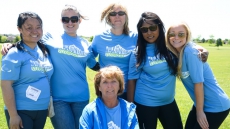Let’s take a moment to run through a list of considerations that an effective fitness resolution should include.
It’s that New Year’s resolution season again. A time when many a fitness resolution will be made, most of which will be broken.
Why do so many fitness resolutions fail? If you ask most people they’ll tell you that it was just too hard. But I don’t think that’s the problem.
I think the problem is that most people don’t make a realistic fitness goal with clearly defined parameters. As a result, they aren’t even sure what success would look like, or what it will take to achieve it.
With this in mind, let’s take a moment to run through a checklist of considerations that an effective fitness resolution should include.
A clearly defined, realistic goal
A lot of resolutions suffer from being too vague: “This year I will lose weight” or “this year I will get in shape” or “from now on I’ll eat better.” What do these statements even mean?
Instead of making these types of open-ended goals, set clear intentions. Pick a specific number of pounds you’d like to lose. Or if you want to get stronger, a specific number of pounds you’d like to gain. Or a specific number of miles you want to be able to run. Whatever it is, get particular.
And keep in mind that if you’re going to achieve your goal, it needs to be achievable. You’re not going to lose 10 pounds by Easter. You’re not going to look like an MMA fighter by summer. You can, however, lose or gain 10 pounds by June. Set longer-term goals like that, then chart your incremental progress along the way.
A fixed nutritional regimen
Most people don’t realize that achieving any fitness goal is a matter of about 80 per cent nutrition and 20 per cent exercise. You can’t exercise your way to fitness. You have to eat your way there.
That means determining exactly how many calories you’ll need to eat each day to lose or gain weight, then creating a meal plan that reflects that calorie limit or goal. A quick Google search for “calorie weight loss calculator” will provide a slew of tools for pinpointing these numbers.
From there it’s a matter of breaking your daily caloric limit into however many meals you expect to eat (opinions vary, but three meals and a snack or two will work fine for most people), then composing meals around these numbers. Bottom line – a clear eating plan is essential to your resolution.

The necessary gear
You don’t need equipment to get fit, but it certainly helps. For example, a good calorie counter app can make it easy to determine caloric goals and track what you’re eating throughout the day. I use MyFitnessPal, which will set calorie and nutrient goals, track what you’re eating, allow you to input exercise to adjust daily calorie needs accordingly, and even connects you to an online community for motivation. This is just one of dozens of similar apps, and I find them invaluable.
Workout clothes, gear for home or outdoor workouts, and so forth – these things not only help you exercise, but the investment provides some mental incentive to stick to it.
A gym membership
Now, this one can be dicey. The majority of gym memberships are purchased within the first two weeks of the year, and 80 per cent of those will quit within five months. But that doesn’t mean you shouldn’t get one. That 20 per cent who tough it out? Those are the people who understood that achieving a fitness resolution is about more than words – it’s about action. They’re the type of people who adhere to checklists like this. They’re the people who will look great by June.
Motivation
Motivation is as practical a necessity as diet or a gym membership. Without it, you probably won’t get far. How does one acquire motivation? It starts internally, by setting those realistic, well-defined goals we already discussed. From there, you augment it.
Part of your fitness resolution could involve finding one of your friends who will join you for runs or at the gym. Or it could involve subscribing to informative and inspiring fitness channels on YouTube. I recommend Dr. Sara Solomon or Buff Dudes or both – highly informative, motivational, and directed toward people of all fitness levels. It could mean getting a journal to chart your progress, or joining an online fitness community.
All told, these five points are the equation for a successful fitness resolution. So with these in mind, don’t let your resolution flop due to vague intentions and a lack of planning. Get specific, get nutritious, get the gear, get to the gym, and get motivated. Pretty soon (but at a realistic pace), you’ll get fit.






